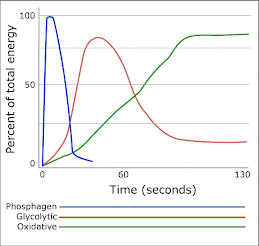There are three biochemical means in which energy is provided for all human action. They are phosphagen, glycolytic, and oxidative. In other words your body gets energy in three ways depending on the demands of the activity you are participating in. We call these energy sources metabolic pathways. Wether you realize it or not we have been training in all three.
The phosphagen pathway provides the bulk of energy used in high powered activities, those that last less than ten seconds.
The glycotic pathway provides energy for activities that last up to several minutes.
The oxidative pathway provides energy for low-powered activities, those that last in excess of several minutes.
There are a lot of complex process that go into energy production and we will skim across that in future blogs but, for this blog I want you to give me an example of an activity for each of the metabolic pathways listed above.
Great SEO Advice for CrossFit Gyms
4 years ago

15 comments:
Harrison Halem- The phosphagen pathway would be demonstrated well in a play of football lasting less then 10 seconds.
The glycotic pathway would be demonstrated in a game of basketball with timeouts or out of bounds every several minutes.
The oxidative pathway would be demonstrated in soccer when players dont come off the field for over 45 minutes at some points.
Phosphagen pathways are used in High powered activities such as power cleans.
Glycotic Pathways are used in activities such as Sidney's and other metcon drills.
Oxidative Pathways are used in activities such as running
- Zach Latter
A phosphagen pathway exercise would be a max out on a bench press. A glycotic pathway exercise would be pushups. An oxidative pathway exercies would be a long jog.
-Zachary Canter
The phosphagen pathway would be used in in sports lasting only a few minutes
The glycotic pathway would be demonstated in sports that has constant stops every several minutes
The oxidative pathway would be used in sport like rugby where there is no stops for about 45 minutes
phospagen pathway could be used in lifting a table onto a truck in one quick motion
the glycotic energy could be used in short sprtins like the 400 or 800
the oxidative pathway would be used for a soccer player
alex dunlop
Phosphgen pathway can be used in football and some track events which last only a few seconds, or even a max deadlift or squat.
Glycotic pathway can be performed in basketball, lacrosse or volleyball were timeouts or fouls occur every few minutes.
Oxidative pathway would be performed in soccer, cross country were playing time is constant.
-John Schmidt
The Phospagen pathway would be running the 100meter dash.
The Glycotic pathway could be demonstrated by a period in a wrestling match.
The oxidative pathway could be demonstrated by cross country running.
Brett Barkley
The phosphagen pathway would be demonstrated well during a 40 yard dash
The glycotic pathway would be demonstrated well during an ice hockey game. You have one minute shifts and you go all out.
The oxidative pathway would be demonstrated well during a cross country run.
-Steven Rubin
phos pathways are used when doing deadlifts at high weight
glyc pathways are used when playing football, with periodic breaks
oxidative pathways are used when doing long distance runs
-Mark Stubenberg
I use the phosphagen pathway as I go for my one-rep max in any of the primary lifts (deadlift, shoulder press, bench, squat)
I use my glycotic pathway as I jump rope single-hop for maybe two or three minutes.
I use the oxidative pathway as I go on a 2-mile run at track practice.
-Weava Weave-
phosphagen pathway- this is used in the 40 yard dash
glycotic pathway- this is used in a lacrosse game where you have to run and be active all the time while you are in with no rests or breaks
oxidative pathway- this is used in jogging for a long period of a time without overworking your body
gordie gold period 7
phosphagen pathway- 40 yard dash
glycotic pathway-mile run
The oxidative pathway - staying in and playing in a high pace sport
A phosphagen activity would be lifting a heavy load only once, like trying to get a max out lift.
A glycotic activity would be a sport like football or sprinting, in which there are short plays that last a few minutes.
An oxidative activity would be a workout such as the filthy fifties.
Marcel Copay
I would say that the phosphagen pathway involves something like an activiy that lasts for less than 10 seconds.
The glycotic pathways are used for activities such as metcon that last for several minutes and involve intense concentration.
The oxidative pathways are used for activities such as a long distace jog since it doesnt reqire alot of energy to jog. ~Riell Swann~
phasogen pathways are used in high powered activities such as short sprints where you go all out for a short amount of time.
Glycotic pathways are used in activites such as cidneys
Oxidative pathways are used ina ctivities such as running long distances
Post a Comment